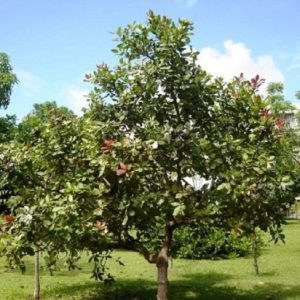Cashewnut can earn farmers in the cattle corridor extra millions
Cashewnut is one of the high value crops that can earn farmers especially in the cattle corridor as high as Shs30m from an acre per year.
Cashewnut (Anacardium occindentale) is a hardy drought resistant tree crop.
It strives best in dry areas with annual average temperatures above 28°C and having well drained deep sandy loam soils with high textural porosity.
This makes it a very suitable commodity for dry cattle corridor areas of Uganda.
Cashewnut offers enormous benefits including; Nutritional benefits where it provides macro and micro nutrients, such as protein, magnesium, zinc, copper, manganese a potential Source of vitamin C.
Industrially, Cashewnut is used in manufacture of varnishes, typewriter rolls, industrial flooring tiles, gum, inks, oil cloth, paints, water-proofing paper, acid and alkali resistant cements, laminating resins among others.
Economically, Cashew is a source of income for smallholder and large scale farmers, provides employment opportunities and foreign exchange earnings for government.
Environmentally, being a hardy drought resistant tree crop, Cashew provides potential benefits to climate change mitigation especially for the dry land areas.
This makes it very suitable for the cattle corridor districts of Uganda.
Tukam Dixon Kyaba, the Executive Director at Cashew Farmers & Promoters National Association of Uganda Ltd, is promoting the crop in collaboration with Ministry of Agriculture, Animal Industry and Fisheries (MAAIF), Government Agencies and Development Partners.
He says the association started about eight years ago to promote cashewnut as a high value crop since it has a lot of opportunities along its value chain.
Kyaba, who is also the Executive Director at Uganda Cashenut & Trees Ltd, says they engaged responsible agencies and President Yoweri Museveni to consider Cashewnut as one of the priority crops that can contribute significantly to the country’s economic growth.
Indeed, on 16th October, 2017, the President directed Ministry of Agriculture Animal Industry and Fisheries (MAAIF) to integrate Cashewnut among the priority commodities and to liaise with Uganda Cashewnut and Trees Limited (UCTL) for development of Cashewnut Value Chain for improving livelihoods of smallholder farmers in the Cattle Corridor Districts of Uganda.
Kyaba says the association he heads is also working with the National Forestry Research Institute (NAFORI) that has developed quality and high yielding cashewnut varieties.
“The original (old) cashewnut varieties have been here for over 60 years. They are no longer productive. After Uganda got Independence, cashewnut was not given attention as much as coffee, tea and cotton. It was abandoned,” Kyaba says.

He adds that the association is building up membership by recruiting farmers into cashewnut farming and training them on how to grow the cash crop.
“We have 12 regional resource centres in the country. People don’t know much about the crop. The few that are growing it know its value. We want more people to know the opportunities along the cashewnut value chain,” he says.
Cashewnut production, Market
Kyaba says Cashewnut production figures in Uganda are still scanty since the crop has been abandoned for the last 60 years.
He says the association has 78 critical farmers who are into large scale (4 acres and above) cashewnut farming. These are spread in about 34 districts in the cattle corridor from Abim through Central Buganda up to Mbarara.
According to MAAIF, there are 42 districts along the dry cattle corridor areas of Uganda including districts in the sub regions of Karamoja, Teso, Lango, Acholi, WestNile, Parts of Central and South Western Uganda.
Kyaba says an acre of land can accommodate about 60-75 trees because spacing is about 10 meters apart.
“Cashewnut trees can live up to 100 years. It starts producing from three years but the yield increases as the tree grows bigger. A tree will give you an average of 6kgs at around five years. A grown up tree of 20 years can give you up to 100kgs per year,” Kyaba says, adding that much as it is a wild tree, they encourage farmers to feed the tree with organic fertilizers especially when they are still young.
“We are encouraging people especially in the cattle corridor to take advantage of the Parish Development Model and plant more cashewnuts,” he says, adding: “We encourage total avoidance of rootstock seedlings as they are not dependable.”
Kyaba further explains that when the trees are still young, they recommend inter-cropping. It is not advisable to inter-crop cashewnut with coffee because the former has a large canopy.
“You can inter-crop with leguminous crops like beans and ground nuts. This can be done up to three years. Thereafter, you can turn it into a livestock farm; you can have goats, cows and sheep there because these trees are wild and can survive even with some grasses,” Kyaba says, adding that this allows farmers to effectively utilize their land and earn more money. He adds that as trees grow bigger, they encourage farmers to take on bee keeping.
Market
Kyaba says global demand for cashewnuts is about 12m metric tonnes per year, but producing countries can only manage to produce only four million metric tonnes. This means eight million metric tonnes stand in balance.
Cashew is grown across the world including countries such as Mexico, Brazil, India, Philippines and other African Countries s including Nigeria, Mozambique, Kenya, Tanzania and Uganda among others.
At 15 years, he says, a cashewnut tree can yield 25kgs per season. There are two seasons in a year, meaning one can harvest 50kgs per year from a single tree. Taking an average of 60 trees in an acre, a farmer can harvest about 3,000kgs of unshelled nuts and if each kilogram is sold at an average price of Shs5,000, a farmer will earn a gross of Shs15.
He adds that the farmer earns more as trees grow bigger.
“The apple like fruit is also beneficial; it can be used to process nutritious juice,” he says of the fruit that holds the nuts.

Kyaba says the association he heads has international buyers but they don’t have the capacity to supply them at the moment.
“We have many international buyers inquiring about the availability of cashewnuts in Uganda but we can’t supply them at the moment. Right now we are focusing on production because most of the buyers want big orders in metric tonnes,” Kyaba says.
He however, adds that many nursery operators are often engaged by the procuring entities, but they are currently stuck with large volumes of seedlings.
Gov’t Interventions
In FY 2019/20, MAAIF through NAADS allocated funds amounting to 1 (One) billion shillings only for procurement of Cashewnut Seedlings of improved varieties. A total of 166,965 improved Cashewnut seedlings were procured in Season 2019A (Season1) and distributed to demonstration farmers which was then planted in 2,000 acres of land in 28 districts in the cattle corridor area of Uganda. In FY 2019/20, MAAIF ringed fenced up to 2 (two) billion shillings for procurement and distribution of Cashewnut Seedlings of improved varieties to demonstration Host Farmers in Season 2019B (Season 2).
In September, 2019 MAAIF initiated the procurement of 333,333 Seedlings of improved Cashewnut Varieties worth 2 Billion Uganda Shillings.
In collaboration with Uganda Cashewnut and Trees Limited, Nursery Operators were identified, inspected and up to 171 Nursery operators submitted bids, evaluated and have signed contract with MAAIF to supply up to 333, 333 seedlings of improved Cashewnut varieties AA7, AC4, AC43, AZA2 and AC10 in 2020.
The Ministry of Agriculture, Animal Industry and Fisheries is currently developing a project to support development of sustainable Cashew nut value chains in Uganda. A total of 61,000 farmers from 61 districts located along the cattle corridor and dry land areas of Uganda are expected to benefit from this project.
For inquiries or to advertise on Business Focus , Tel: 0775170346 (WhatsApp)/0705888301/staddewo@gmail.com
Follow us on Twitter: @BusinessFocusug, @TaddewoS
For genuine and quality Clonal Coffee Planting materials, contact Pearl Model Farm via: 0775170346 (WhatsApp)/0703828741/staddewo@gmail.com







We promote agroforestry with focus on sustainable fruit farming cashew, oranges and macadamia. We need to have membership of Uganda cashew and tree farmers. Any guidance, we are in northern uganda.
I am interested in establishing a garden of cashew nuts. Please, send me the contact for: Cashew Farmers and Promoters National Association of Uganda Limited,
and any other source for seedlings.